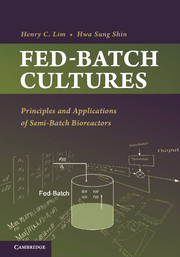Book contents
- Frontmatter
- Contents
- Preface
- Acknowledgments
- 1 Introduction to Fed-Batch Cultures
- 2 Idealized Reactors and Fed-Batch Reactors
- 3 Maximization of Reaction Rates and Fed-Batch Operation
- 4 Phenomena That Favor Fed-Batch Operations
- 5 Classification and Characteristics of Fed-Batch Cultures
- 6 Models Based on Mass Balance Equations
- 7 Non–Equation-Based Models
- 8 Specific Rate Determination
- 9 Optimization by Pontryagin's Maximum Principle
- 10 Computational Techniques
- 11 Optimization of Single and Multiple Reactions
- 12 Optimization for Cell Mass Production
- 13 Optimization for Metabolite Production
- 14 Simple Adaptive Optimization
- 15 Measurements, Estimation, and Control
- 16 Feasibility Assessment and Implementable Feed Rates
- Index
- References
14 - Simple Adaptive Optimization
Published online by Cambridge University Press: 05 April 2013
- Frontmatter
- Contents
- Preface
- Acknowledgments
- 1 Introduction to Fed-Batch Cultures
- 2 Idealized Reactors and Fed-Batch Reactors
- 3 Maximization of Reaction Rates and Fed-Batch Operation
- 4 Phenomena That Favor Fed-Batch Operations
- 5 Classification and Characteristics of Fed-Batch Cultures
- 6 Models Based on Mass Balance Equations
- 7 Non–Equation-Based Models
- 8 Specific Rate Determination
- 9 Optimization by Pontryagin's Maximum Principle
- 10 Computational Techniques
- 11 Optimization of Single and Multiple Reactions
- 12 Optimization for Cell Mass Production
- 13 Optimization for Metabolite Production
- 14 Simple Adaptive Optimization
- 15 Measurements, Estimation, and Control
- 16 Feasibility Assessment and Implementable Feed Rates
- Index
- References
Summary
In previous chapters, optimizations were carried out using known models with fixed parameter values. The assumption was that the model and its parameter values remain practically invariant during the entire course of bioreactor operation. This assumption may not hold in reality. First, because the model used is only an approximation of real cellular processes, it may not represent well the process over the entire operational time period. The rate-limiting step may change during the course of operation, for example, the rate-limiting step in the cell growth phase may not be the same as that in the product formation phase. To overcome the shortcomings of a fixed model with fixed values of parameters, it may be necessary to allow the parameter values to vary or even to alter the model during the course of the operational time period to obtain a model that better fits the experimental data.
The objective of adaptive optimization is to optimize the process under uncertainties in model and/or parameter values. In this chapter, we consider only simple adaptive optimization schemes with a fixed model with adjustable parameters; the parameter values are updated after one run using the experimental data generated, and the optimization is repeated and implemented in the subsequent run. This process is repeated run after run (cycle-to-cycle, off-line optimization). Alternatively, within one run, the operational time may be divided into a number of time intervals, and the parameter values may be updated from one time interval to the next time interval during the course of one run using the experimental data generated in previous time intervals, and the optimization may be repeated from one time interval to the next with the updated parameter values and implemented in the subsequent time interval (on-line adaptive optimization). This process may be repeated from one interval to the next, until the entire time interval is covered.
- Type
- Chapter
- Information
- Fed-Batch CulturesPrinciples and Applications of Semi-Batch Bioreactors, pp. 393 - 406Publisher: Cambridge University PressPrint publication year: 2013



